An Improved Synthetic Eddy Method for Generating Inlet Turbulent Boundary Layers
Abstract
1. Introduction
- The traditional SEM seems to overestimate the eddy radii in the near wall region. The radii reach the maximum ( is the boundary layer thickness) at the approximate position of . The grids near the wall will be affected by too many eddies, which cause much larger vortex structures to be generated than small vortex structures. In the compressible LES study of Mankbadi et al. [17], it is found that SEM could succeed in replicating the Reynolds stress tensor when the radii of the eddies are taken as after a preliminary boundary layer study where the radii were varied, while the moving speed of the eddies is . This also indicated overestimates of the eddy radii in the near-wall region. Detailed comparisons of the radii can be seen in Section 3.
- The velocity of the actual vortex structures should be close to the average velocity of the turbulent boundary layer. The velocity of vortex structures in the near wall region is much lower than that in the outer layer of the boundary layer. Therefore, it is unreasonable to set all the eddy moving velocities as the mainstream velocity . This may be the reason Mankbadi et al. [17] chose eddy moving velocities.
- The vortex points are evenly distributed in the eddy region at the first step, and the vortex points leaving the outlet plane of the eddy region are regenerated on the inlet plane of the vortex region, which means . This will cause a problem. After several or more steps, the streamwise distribution of the vortex will be sorted to several points at a time step away, thus losing the randomness of the flow direction, which is shown in Figure 1.
2. Numerical Methods
2.1. NS Code
2.2. Theory of the SEM
- (1)
- The eddies are evenly initialized in the synthetic vortex region with a certain radius and carry random information that can influence the generation of turbulent fluctuations at the first iteration. All information about the eddy can be expressed as , where is the initialized location in the synthetic vortex region, determines the directions of the velocity fluctuations, and and are the radius and the moving velocity of the eddy, respectively. All the eddy information remains unchanged until the eddy regenerates, except .
- (2)
- The eddies in motion disturb the grid points within their radii, affecting the generation of velocity fluctuations. The velocity of a grid point on the inlet boundary can be expressed as:where represents the three spatial directions, is the time-averaged velocity, and is the pulsation velocity.
- (3)
- Once an eddy escapes from the outlet plane of the synthetic eddy region, it is regenerated randomly in the inflow plane synthetic vortex region to keep the total number of eddies constant, which can be given as:
3. Improved SEM
- The radius profile of eddies is shown as in Figure 4. It is defined as:where is the distance of the eddies to the wall. The linear distribution along the wall normal direction is adopted. We also tried the velocity distribution of a velocity profile shape, which was slightly different from the linear distribution. Therefore, we use the linear distribution for ease of use. The profile is adopted by Mankbadi et al. [17]. Compared with the profile of the radii of the eddies proposed by Jarrin et al. [12], the profile proposed in this paper reduces the eddy radii near the wall, while it is closer to that proposed by Mankbadi et al. [17].
- 2.
- The moving velocity of the eddies adopts the average velocity of the turbulent boundary layer. However, to avoid the parallel efficiency loss caused by the interpolation of the velocity of the eddies regenerated in each iteration, an approximate expression [20] of the velocity profile is adopted. Therefore, the position of each eddy is updated after a time stepand remain constant before the eddy vanishes.
- 3.
- The new positions of the eddies are set as follows when the streamwise positions of the eddies are greater than
4. Application of the Improved SEM to a Supersonic Plate Flow
5. Conclusions
- (1)
- The velocities of the eddies are redefined according to the distance of the eddies from the wall in the synthetic eddy region, as the traditional SEM overestimates the eddy radii in the near wall region.
- (2)
- The moving velocity of the eddies adopts the average velocity of the turbulent boundary layer. An approximate expression, [20], of the velocity profile is adopted to avoid velocity interpolation.
- (3)
- Regenerated streamwise coordinates of the eddies in the synthetic eddy region are also modified to avoid random reduction.
Author Contributions
Funding
Conflicts of Interest
References
- Guarini, S.E.; Moser, R.D.; Shariff, K.; Wray, A. Direct numerical simulation of a supersonic turbulent boundary layer at Mach 2.5. J. Fluid Mech. 2000, 414, 1–33. [Google Scholar] [CrossRef]
- Dhamankar, N.S.; Blaisdell, G.A.; Lyrintzis, A.S. Overview of Turbulent Inflow Boundary Conditions for Large-Eddy Simulations. AIAA J. 2018, 56, 1317–1334. [Google Scholar] [CrossRef]
- Schlüter, J.U.; Pitsch, H.; Moin, P. Large-Eddy Simulation Inflow Conditions for Coupling with Reynolds-Averaged Flow Solvers. AIAA J. 2004, 42, 478–484. [Google Scholar] [CrossRef][Green Version]
- Schlüter, J.U.; Wu, X.; Kim, S.; Shankaran, S.; Alonso, J.J.; Pitsch, H. A Framework for Coupling Reynolds-Averaged with Large-Eddy Simulations for Gas Turbine Applications. J. Fluids Eng. 2005, 127, 806–815. [Google Scholar] [CrossRef]
- Keating, A.; Piomelli, U.; Balaras, E.; Kaltenbach, H.-J. A priori and a posteriori tests of inflow conditions for large-eddy simulation. Phys. Fluids 2004, 16, 4696–4712. [Google Scholar] [CrossRef]
- Lund, T.S.; Wu, X.; Squires, K.D. Generation of Turbulent Inflow Data for Spatially-Developing Boundary Layer Simulations. J. Comput. Phys. 1998, 140, 233–258. [Google Scholar] [CrossRef]
- Mochida, A.; Lun, I.Y.F. Prediction of wind environment and thermal comfort at pedestrian level in urban area. J. Wind Eng. Ind. Aerodyn. 2008, 96, 1498–1527. [Google Scholar] [CrossRef]
- Uzun, A.; Hussaini, M.Y. Simulation of Noise Generation in the Near-Nozzle Region of a Chevron Nozzle Jet. AIAA J. 2009, 47, 1793–1810. [Google Scholar] [CrossRef]
- Wang, M.; Moin, P. Computation of Trailing-Edge Flow and Noise Using Large-Eddy Simulation. AIAA J. 2000, 38, 2201–2209. [Google Scholar] [CrossRef]
- Mathey, F.; Cokljat, D.; Bertoglio, J.P.; Sergent, E. Assessment of the vortex method for Large Eddy Simulation inlet conditions. Prog. Comput. Fluid Dyn. Int. J. 2006, 6, 58. [Google Scholar] [CrossRef]
- Xie, Z.-T.; Castro, I.P. Efficient Generation of Inflow Conditions for Large Eddy Simulation of Street-Scale Flows. Flow Turbul. Combust. 2008, 81, 449–470. [Google Scholar] [CrossRef]
- Jarrin, N.; Benhamadouche, S.; Laurence, D.; Prosser, R. A synthetic-eddy-method for generating inflow conditions for large-eddy simulations. Int. J. Heat Fluid Flow 2006, 27, 585–593. [Google Scholar] [CrossRef]
- Jarrin, N.; Prosser, R.; Uribe, J.C.; Benhamadouche, S.; Laurence, D. Reconstruction of turbulent fluctuations for hybrid RANS/LES simulations using a Synthetic-Eddy Method. Int. J. Heat Fluid Flow 2009, 30, 435–442. [Google Scholar] [CrossRef]
- Pamiès, M.; Weiss, P.-É.; Garnier, E.; Deck, S.; Sagaut, P. Generation of synthetic turbulent inflow data for large eddy simulation of spatially evolving wall-bounded flows. Phys. Fluids 2009, 21, 045103. [Google Scholar] [CrossRef]
- Poletto, R.; Craft, T.; Revell, A. A New Divergence Free Synthetic Eddy Method for the Reproduction of Inlet Flow Conditions for LES. Flow Turbul. Combust. 2013, 91, 519–539. [Google Scholar] [CrossRef]
- Tabor, G.R.; Baba-Ahmadi, M.H. Inlet conditions for large eddy simulation: A review. Comput. Fluids 2010, 39, 553–567. [Google Scholar] [CrossRef]
- Mankbadi, M.R.; DeBonis, J.R.; Georgiadis, N.J. Large-Eddy Simulation of a Compressible Mixing Layer and the Significance of Inflow Turbulence. In Proceedings of the 55th AIAA Aerospace Sciences Meeting, Grapevine, TX, USA, 9–13 January 2017; American Institute of Aeronautics and Astronautics: Reston, VA, USA, 2017. [Google Scholar]
- Lee, S.; Gross, A. Large-Eddy Simulation of Supersonic Turbulent Boundary Layer. In Proceedings of the AIAA AVIATION 2020 FORUM, Virtual Event, 15–19 June 2020; American Institute of Aeronautics and Astronautics: Reston, VA, USA, 2020. [Google Scholar]
- Lai, J.; Yu, H.; Tian, Z.; Li, H. Hybrid MPI and CUDA Parallelization for CFD Applications on Multi-GPU HPC Clusters. Sci. Program. 2020, 2020, 8862123. [Google Scholar] [CrossRef]
- Gjøsund, S.H. Simplified Approximate Expressions for the Boundary Layer Flow in Cylindrical Sections in Plankton Nets and Trawls. Open J. Mar. Sci. 2012, 2, 66–69. [Google Scholar] [CrossRef]
- Van Driest, E.R. Turbulent Boundary Layer in Compressible Fluids. J. Aeronaut. Sci. 1951, 18, 145–160. [Google Scholar] [CrossRef]
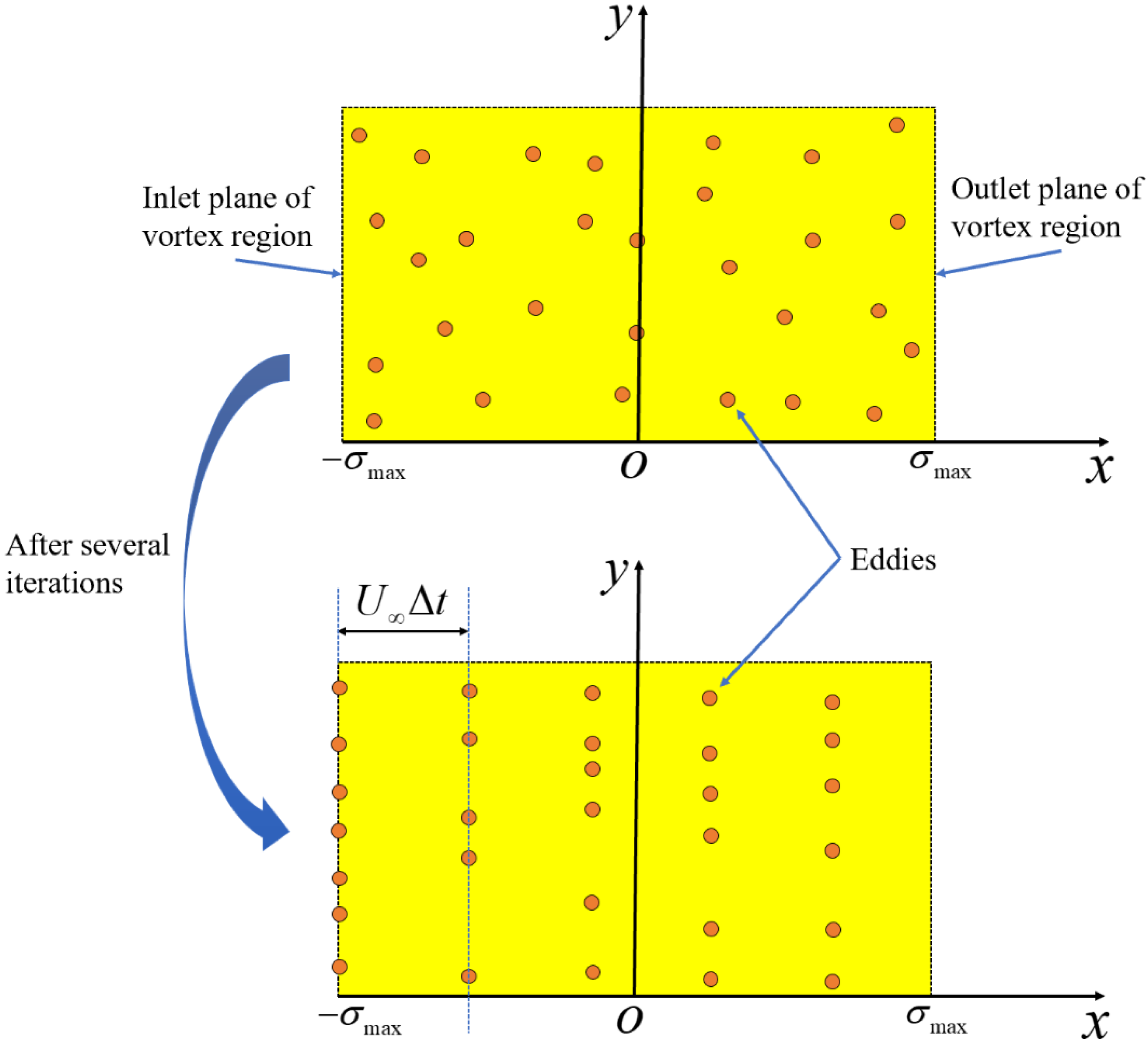

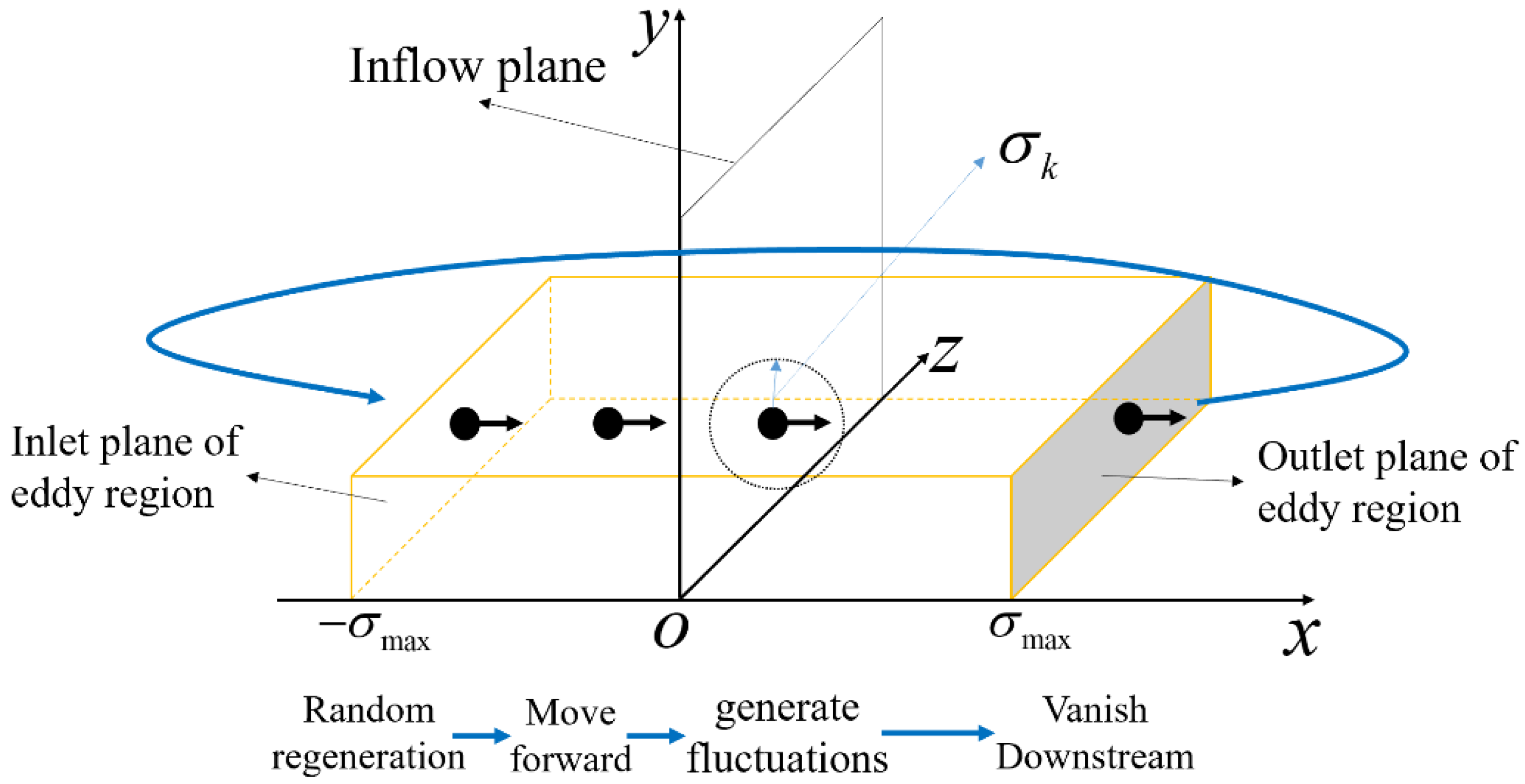



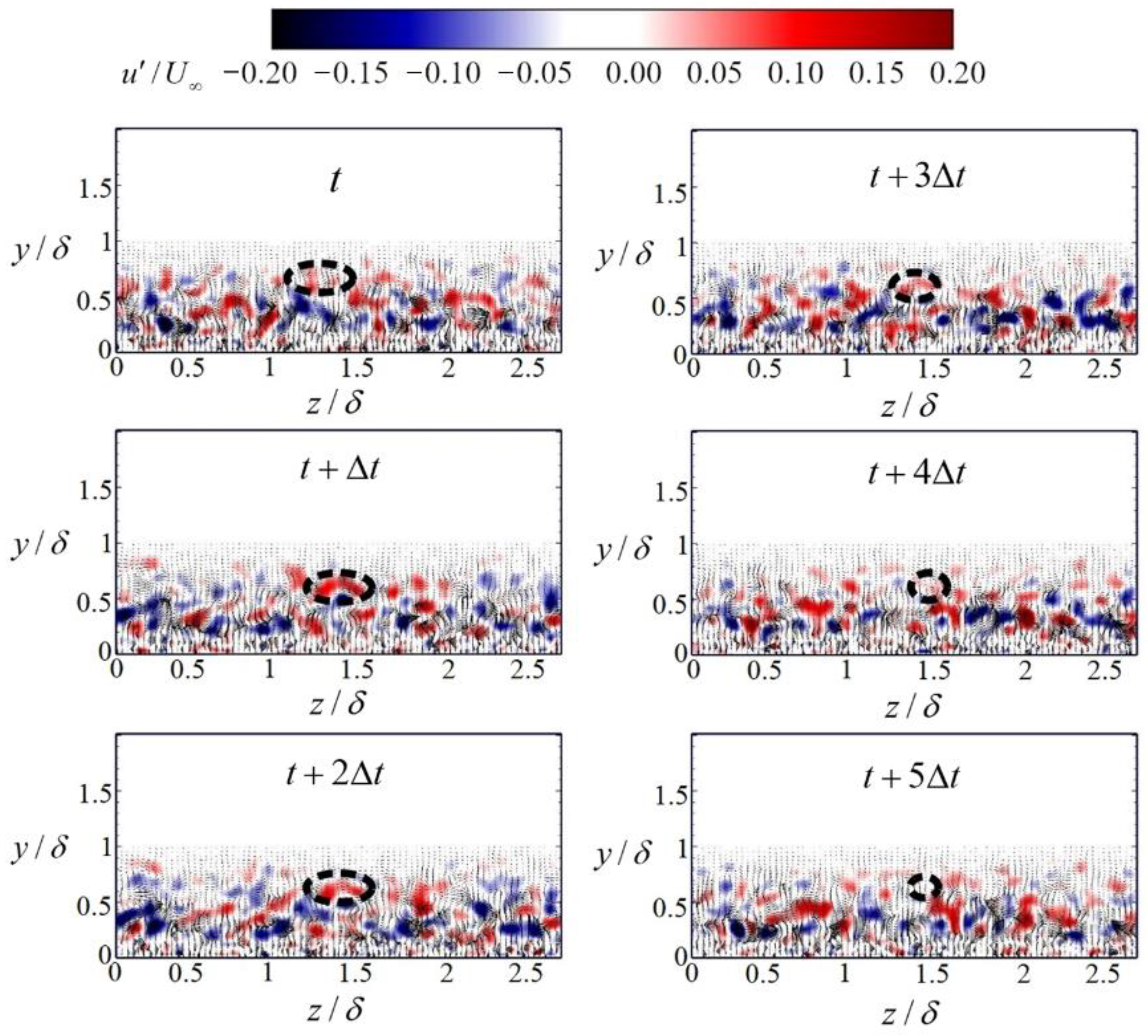


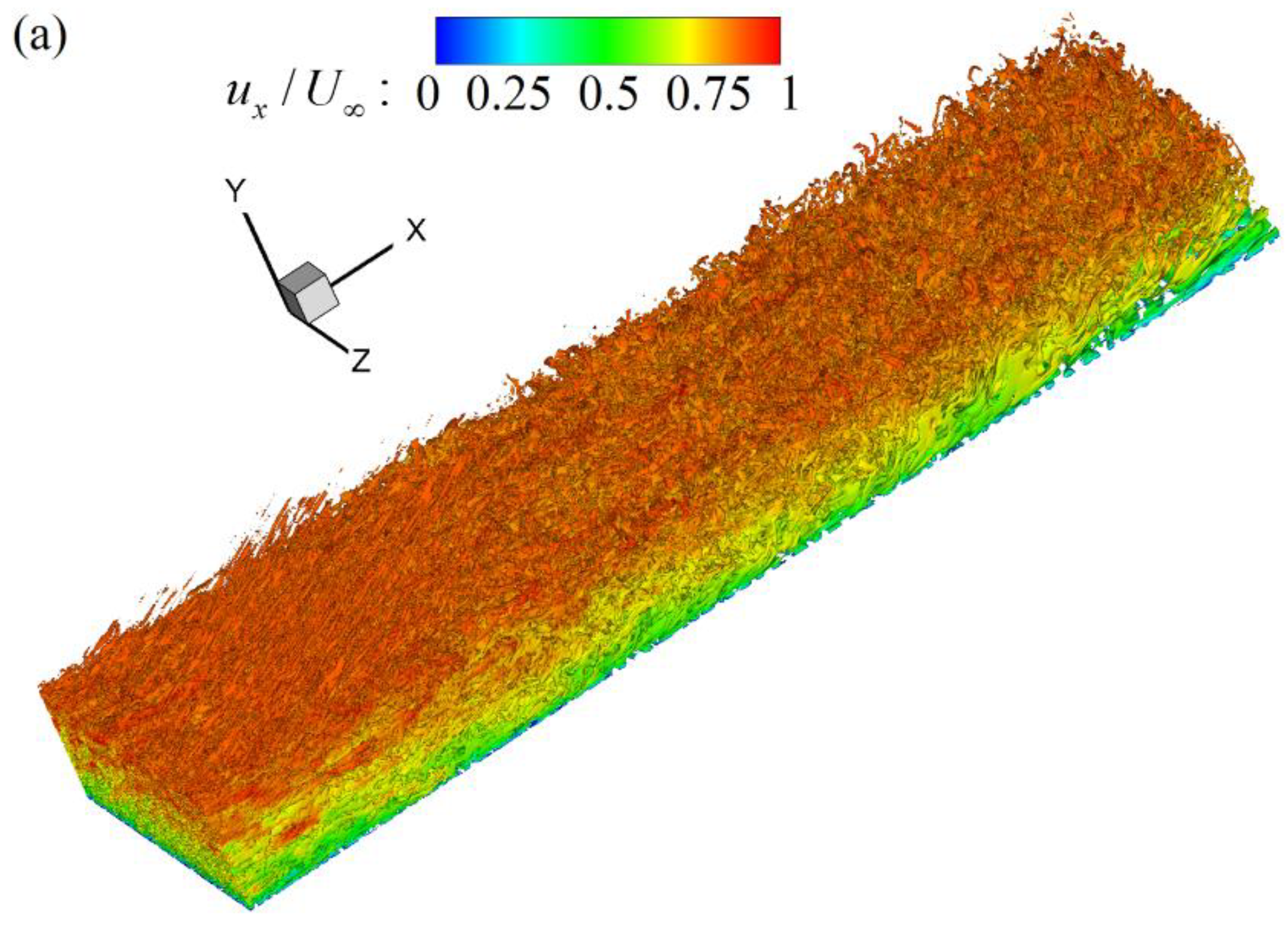

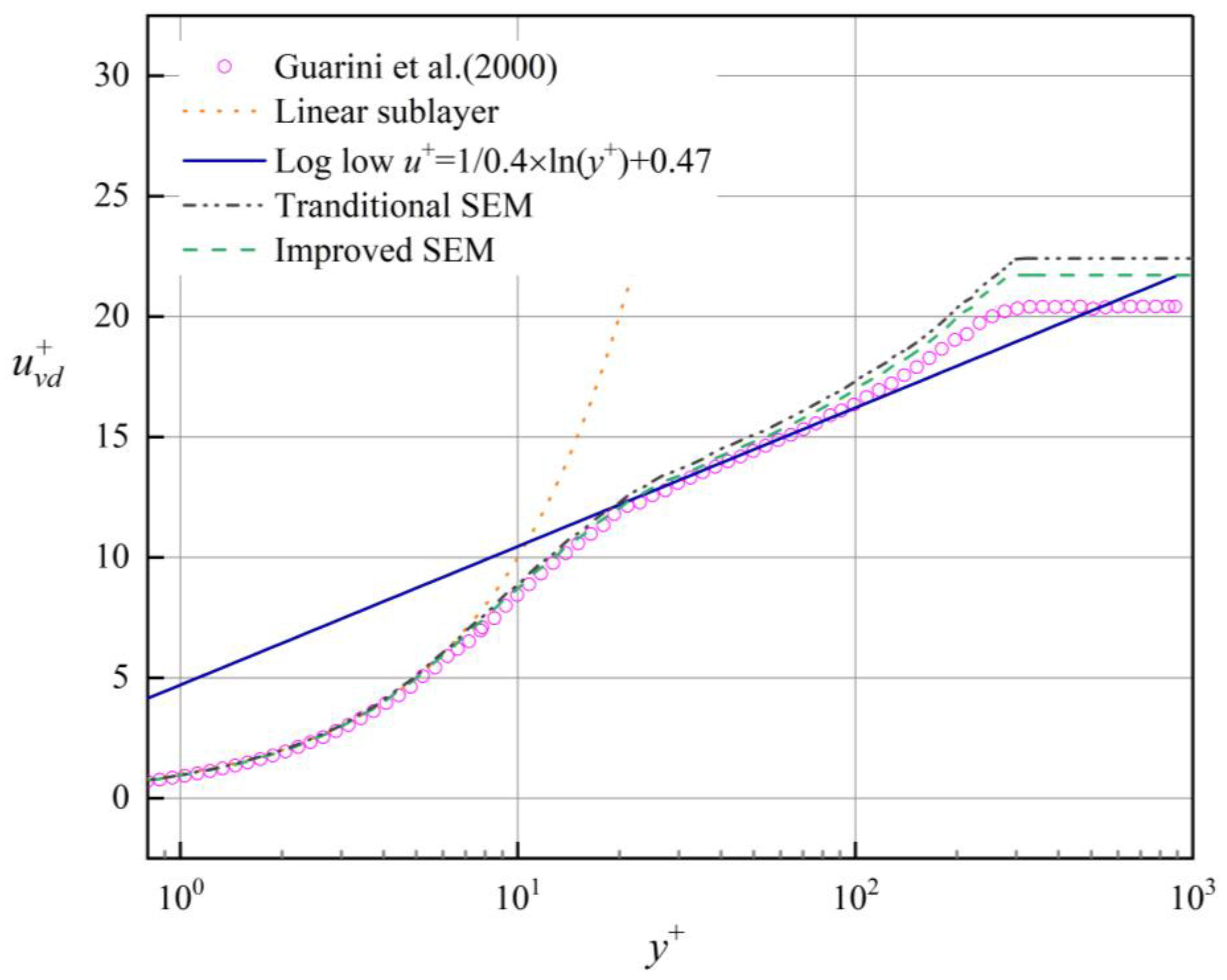
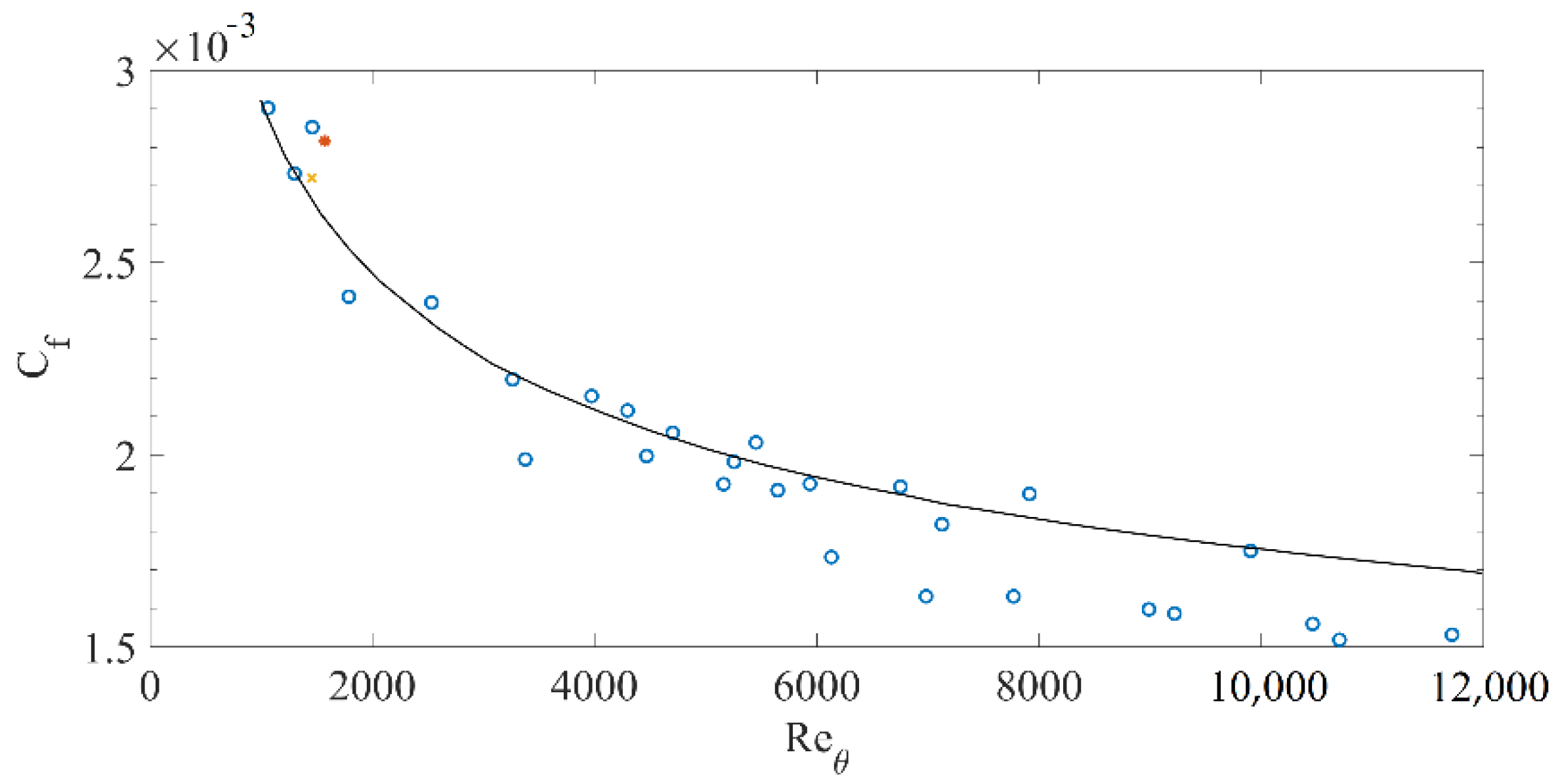
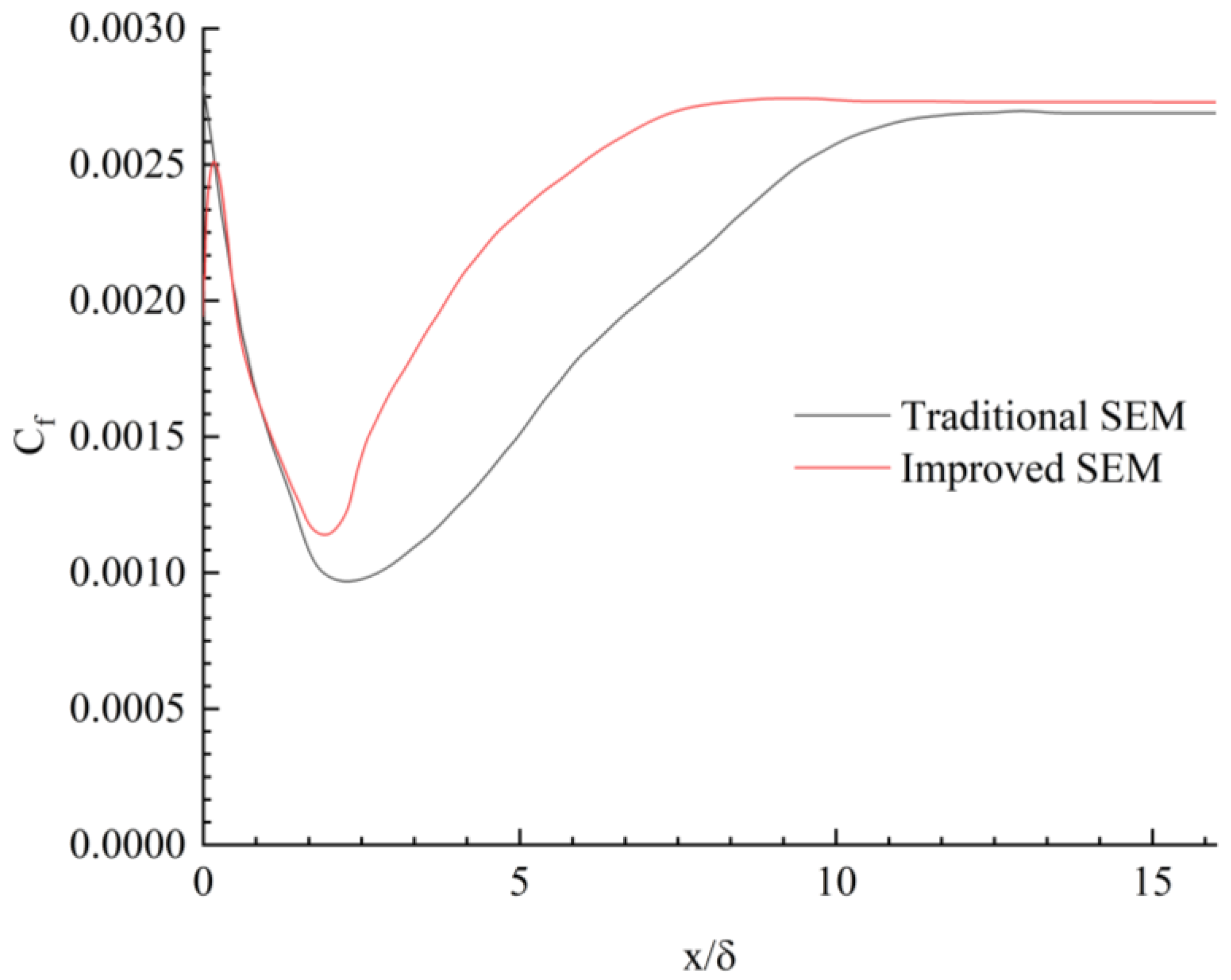

| Total (Million) | ||||||
| 473 | 360 | 270 | 45.98 | 8.2–13.2 | 1–12 | 4.1 |
Publisher’s Note: MDPI stays neutral with regard to jurisdictional claims in published maps and institutional affiliations. |
© 2022 by the authors. Licensee MDPI, Basel, Switzerland. This article is an open access article distributed under the terms and conditions of the Creative Commons Attribution (CC BY) license (https://creativecommons.org/licenses/by/4.0/).
Share and Cite
Xiong, D.; Yang, Y.; Wang, Y. An Improved Synthetic Eddy Method for Generating Inlet Turbulent Boundary Layers. Aerospace 2022, 9, 37. https://doi.org/10.3390/aerospace9010037
Xiong D, Yang Y, Wang Y. An Improved Synthetic Eddy Method for Generating Inlet Turbulent Boundary Layers. Aerospace. 2022; 9(1):37. https://doi.org/10.3390/aerospace9010037
Chicago/Turabian StyleXiong, Dapeng, Yinxin Yang, and Yanan Wang. 2022. "An Improved Synthetic Eddy Method for Generating Inlet Turbulent Boundary Layers" Aerospace 9, no. 1: 37. https://doi.org/10.3390/aerospace9010037
APA StyleXiong, D., Yang, Y., & Wang, Y. (2022). An Improved Synthetic Eddy Method for Generating Inlet Turbulent Boundary Layers. Aerospace, 9(1), 37. https://doi.org/10.3390/aerospace9010037






